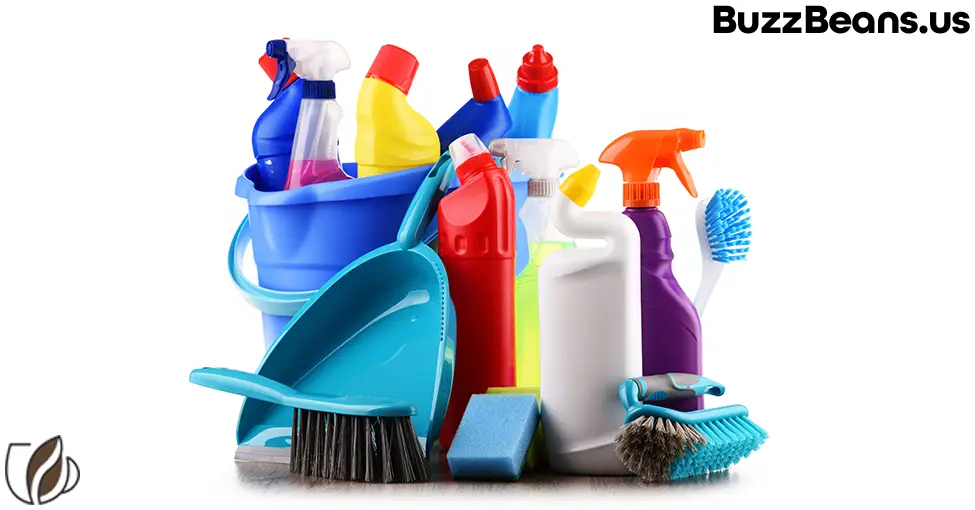Your coffee maker isn’t likely as clean as you think, so here’s how you clean your coffee maker!
Some of the major warning signs of a dirty coffee maker include:
- Oily sludge and mineral buildup inside your coffee maker and pot
- Longer than normal brew times
- Bitter coffee

While the above are all tell-tale signs, you really need to worry about the germs and bacteria that you can’t see.
One study by the National Sanitation Foundation (NSF) International states that coffee makers are the fifth most germ-infested place in your home. The frontrunners included dish sponges, kitchen sinks, toothbrush holders, and pet food/water bowls. NSF International found that most reservoirs contained yeast and mold…gross! The presence of yeast and mold can cause allergic reactions or even infections. This should be more than enough reason for you to properly clean your coffee maker.
The overall filthiness of your coffeemaker is disturbing. However, you can easily and quickly clean your coffee maker so it sparkles and brews your coffee to the best of its ability. In this article, we’ll walk through how to clean a traditional drip-style coffee maker using only vinegar and water. We will also review how to descale a single-serve coffee maker. Regardless of the kind of coffee maker, you’ll need to set aside ample time to allow the vinegar to do its thing, so don’t clean your coffee maker if you need to brew a pot right away.
How to Clean a Coffee Maker
If you use your coffee maker on a daily basis, you should aim to clean it once a month. If you brew coffee on a less regular basis, you should plan on cleaning your coffee maker once every three to six months. Regardless of your brewing frequency, any sort of visible buildup around the pot or basket, or if your coffee doesn’t taste right, it’s time to clean your coffee maker.

What You Need
- Dirty coffee maker
- Distilled white vinegar
- Water
- Coffee filters
- Cleaning cloth or paper towel
Step 1: Fill Coffee Maker with Vinegar & Water
The first thing you want to do is fill the reservoir with a 50/50 mix of distilled white vinegar and water. You can increase the ratio of vinegar to water if your coffee maker has an extreme case of buildup. The vinegar will sanitize the coffee maker and carafe and dissolve any mineral deposits.
Step 2: Brew & Let It Soak
Next, you want to position a filter in the basket and turn your coffee maker on. When you’re roughly halfway through the brewing process, turn your coffee maker off and allow the remaining vinegar solution to soak in the carafe and reservoir for 30-60 minutes. The soak period depends on how much build-up you need to clear away.

Step 3: Finish the Brewing Cycle & Flush with Water
After you let the vinegar soak in the carafe and reservoir, turn your coffee maker back on and let it complete the brewing cycle. Once the cycle finishes, remove the filter and pour out the vinegar solution.
Now it’s time to rid your coffee maker of the stench and taste left behind by the vinegar solution. You’ll want to fill the reservoir with fresh water, place a fresh filter in the basket, turn the coffee maker on, and let it complete a full cycle. Once it finishes, remove the filter, pour out the water, and repeat with clean water for a second cycle. After the second cycle, you’ll want to wipe down your coffee maker and pot with a clean cloth.
How to Clean a Single-Serve Coffee Maker
Cleaning your single-serve coffee maker is not more complicated than cleaning a traditional drip-pot coffee maker. Just as you would with a standard coffee maker, distilled white vinegar and water are the key cleaning elements.
What You Need
- Dirty single-serve coffee maker
- Liquid dish detergent
- Towel
- Toothbrush
- Cleaning cloth
- All-purpose cleaner
- Distilled white vinegar
- Water
- Empty cup
Step 1: Clean the Exterior
Before you start to descale your single-serve coffee maker, you should give the exterior a good wipe-down. You can toss the reservoir, drip tray, and its cover, and the holder and funnel in your dishwasher. However, do not place the reservoir lid in the dishwasher. You can also place the above equipment in a sink filled with hot water and a teaspoon of liquid dish detergent. If you opt for the sink option, you’ll want to let everything soak for 15 minutes, then rinse and towel dry everything.
Step 2: Clean the Interior
While the removable parts are in the dishwasher or soaking in the sink, you’ll want to take a clean toothbrush and gently brush out any coffee grounds that are stuck in the cup holder. While you’re in there, use a damp cloth to remove any buildup. Lastly, finish the job by wiping down the exterior with a cloth dampened with an all-purpose cleaner.
If you notice limescale deposits – any sort of white crusty buildup – simply soak part of your cloth in white vinegar, apply it to the buildup and let it soak for a few minutes. Again, wipe it down and the crusty buildup should be gone. Finally, re-assemble the single-serve coffee maker.
Step 3: Run the Vinegar Solution
Before you start cleaning your single-serve coffee maker, make sure there isn’t a pod inside. Once you’ve checked for a pod, place a large empty mug on the tray. With the mug in place, empty any water from the reservoir and remove the filter if you have one.
Next, you’ll want to refill the reservoir to the maximum line with a solution of distilled vinegar and water in a 1:1 ratio. Once full, turn the single-serve coffee maker on, select the largest cup setting and allow the vinegar solution to run through the machine as many times as it takes for the “Add Water” light to come on. Make sure you dump the hot liquid from the mug into your sink after each cycle.
Step 4: Let Sit and Rinse the Reservoir
Let your single-serve coffee maker sit for at least 30 minutes. After waiting for 30 minutes, take out the reservoir and rinse it with water to rid it of any vinegar residue.
Step 5: Run Water through Your Single-Serve Coffee Maker
Repeat step 3, except using plain water to rinse out the vinegar solution from the machine. Again, place an empty mug on the drip tray. Pour water into the reservoir up to the maximum line. Set it to brew at the largest cup setting and allow the water to run through the machine as many times as it takes until the reservoir is empty. Now you have a clean single-serve coffee maker ready to brew up your favorite cup of coffee!




